Best Insulation For Mobile Home Roof (2024 Update)
Are you looking to upgrade the insulation in your mobile home roof? Proper insulation is crucial for comfort and energy efficiency in a mobile home. When selecting insulation, there are a few key factors to consider before making a purchase.
First, examine the current insulation. Is there existing insulation that just needs to be replaced or supplemented? Understanding what’s already there will help determine how much new insulation you need. Also inspect the roof decking. Patch any damaged areas that could lead to heat loss.
Next, determine your climate zone and insulation goals. Do you live in a hot or cold region? Are you mainly concerned about keeping your home cool in summer or warm in winter? Your climate and priorities will help guide the insulation type and R-value you select. A higher R-value provides greater insulating power.
Finally, consider your budget. Though more expensive initially, higher quality insulation will pay for itself over time through utility bill savings. Weigh the upfront cost vs. long-term energy efficiency when selecting insulation. Fiberglass and spray foam are two common types of insulation with different costs and benefits.
Installing the right insulation improves comfort and saves money month after month. With some thoughtful planning using the factors above, you can choose the ideal insulation to make your mobile home cozier. Ready to learn more? Keep reading to explore your insulation options in detail!
10 Best Insulation For Mobile Home Roof
| # | Product Image | Product Name | Product Notes | Check Price |
|---|---|---|---|---|
|
1
|
It is ideal for reducing heat gain and improving energy efficiency in attics.
|
|
||
|
2
|
It is ideal for weatherproofing attics, windows, garages, and insulating pipes to keep them at an optimal temperature.
|
|
||
|
3
|
This product is ideal for providing thermal insulation and vapor barrier for residential and commercial buildings.
|
|
||
|
4
|
Ideal for providing thermal insulation and reflecting radiant heat in buildings, attics, garages, and metal structures.
|
|
||
|
5
|
Ideal for providing thermal insulation, reducing radiant heat and blocking moisture in a range of building applications.
|
|
||
|
6
|
This product is ideal for providing thermal insulation, water resistance, and meeting fire safety codes in various applications.
|
|
||
|
7
|
This product is ideal for insulating pipes, air ducts, attics, basements, roofs, saunas, and weatherization.
|
|
||
|
8
|
It is ideal as a thermal barrier and reflective insulation to regulate temperature and reduce energy costs.
|
|
||
|
9
|
This product is ideal for use as a reflective insulation in attics, roofs, and house wraps to save energy.
|
|
||
|
10
|
This product is ideal for insulating roofs, attics, and houses while reflecting solar energy and reducing tear.
|
|
1. 1000 Sqft Diamond Radiant Barrier Solar Attic Foil Reflective Insulation 4×250 By Aes
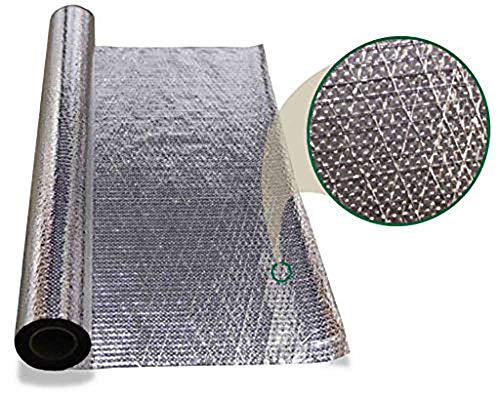
Looking for a reliable and efficient radiant barrier for your home or office? Look no further than the Double Sided Diamond perforated breathable radiant barrier! Measuring 4ft wide by 250 feet in length, this roll provides you with 1,000 square feet of coverage, making it an ideal choice for both new construction and retrofit projects.
One of the key features of this radiant barrier is its highly reflective double-sided metalized aluminum barrier. With a reflectivity rating of 99.97% and an E value that is highly reflective, this barrier is designed to reflect radiant heat rather than absorb it, helping to keep your space cool and comfortable all year round.
In addition to its superior reflective properties, the Diamond Residential Grade Scrim reinforced barrier is also easy to install. It cuts easily with a utility knife or scissors, making it a breeze to install properly.
And, unlike other insulation options, this radiant barrier is non-toxic, does not promote the growth of fungi or bacteria, and does not provide nesting support for rodents or insects. It is also unaffected by humidity and climate changes, so no further maintenance is required once it is installed.
This radiant barrier is also ASTM compliant with a Class 1 Class A fire and smoke safety rating, meeting the requirements of most state and local building codes. It also meets breathability standards for building materials, making it an ideal choice for a range of applications, from attic rafters and floors to garages, workshops, storage units, barns, warehouses, and even older multi-storied homes that lack sufficient insulation.
And, if you're not completely satisfied with your purchase, no problem! This product comes with a 120-day 100% money back guarantee. So why wait? Invest in the Double Sided Diamond perforated breathable radiant barrier today and enjoy a more comfortable and energy-efficient space tomorrow!
2. Double Bubble Insulation For Weatherproofing Attics & Windows.
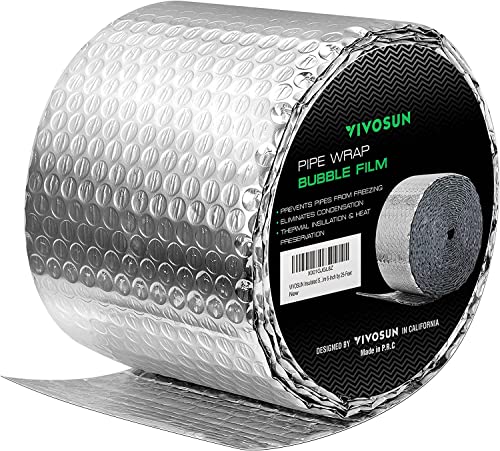
This aluminum foil insulation is a versatile and effective solution for a variety of insulation needs. Measuring 6 inches by 25 feet, it is made of high-quality aluminum foil. The instructions are simple, wrap the insulation around pipes or ductwork, overlapping about every 1/2-inch as you use.
The double bubble insulation design creates more airspace, which makes it better at slowing heat transfer. The 99.9% pure aluminum is bonded to a tear-resistant polymeric core, making it an excellent thermal barrier for water and noise.
With 10mm-diameter double bubbles, the insulation provides airspace between the pipe and wrap, which aids in insulating value. Additionally, both sides of the insulation are lined with aluminum foil, which reflects up to 97% of light, making it an ideal option for reflecting optimal lighting to the plants for better growth.
This bubble foil insulation is versatile and can be used for a wide range of applications. It is a popular choice for metal buildings, pole barns, basements, and other places that require a vapor barrier.
3. Reflective Foil Insulation For Energy Efficiency
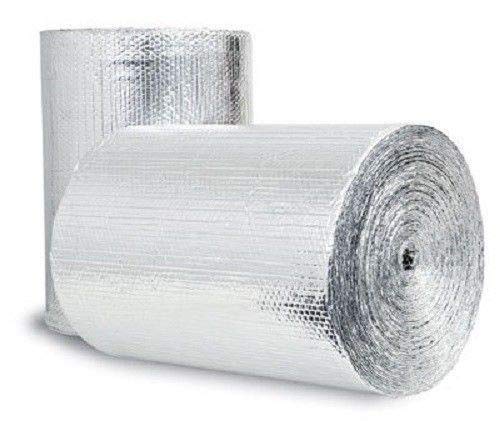
The industrialized air bubble insulation has been designed to provide two layers of polyethylene for durability and strength. The material is lightweight and can hold staples without tearing, ensuring that it does not compress, collapse, or disintegrate. The highly reflective metalized aluminum polyester film is bonded to the insulation to reflect 97% of radiant heat and emit less than 3% of heat. This Class 1 / Class A fire rated radiant barrier has passed the ASTM E84 test & ASTM E2599.
The insulation is non-toxic, non-carcinogenic, and fiber-free, making it safe to handle without requiring protective clothing or respirators. It is easy to install and maintenance-free, and can be cut with a utility knife or scissors. Installation is easier than fiberglass as it can be stapled, nailed, or glued into place without causing any mess or itchy fibers.
The insulation is not affected by moisture or humidity and inhibits condensation. By reducing the stress on heating and cooling systems, it saves energy and keeps your home warmer in the winter and cooler in the summer. The industrialized air bubble insulation can reduce utility bills substantially all year round.
The product is made in the USA and meets all International and USA Fire Codes. Its nominal thickness is 1/4 inch R8-24, and it is a reliable and efficient way to insulate your home.
4. Us Energy Products 48" X 100' White Double Bubble Reflective Foil Insulation Thermal Barrier R8
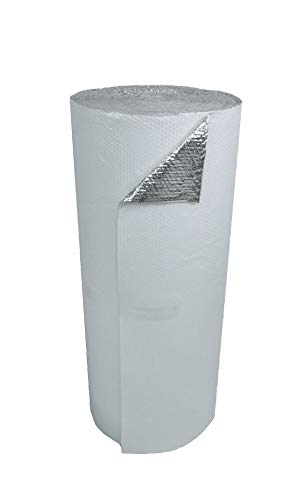
The 4ft x 100ft White Double Bubble is an exceptional product that is perfect for those who want a durable and reliable insulation material. This product is Class 1 / Class A Fire Rated ASTM Certified which assures you of its quality and safety. It is made in the USA and is available for super-fast shipping, making it a convenient choice for those who need insulation materials immediately.
One of the key features of this product is its safety. It is non-toxic, non-carcinogenic, fiber-free, and does not support the growth of mold, mildew, insects, or rodents. This makes it an ideal choice for homes and commercial properties where safety is of utmost importance.
The 4ft x 100ft White Double Bubble is an excellent insulation material that is designed to provide maximum energy savings. It is made from high-quality materials that are designed to withstand harsh weather conditions, ensuring that your property remains comfortable and energy-efficient.
With its Class 1 / Class A Fire Rating ASTM certification, you can be assured that this product has undergone rigorous testing and meets the highest standards of quality and safety. Plus, it is made in the USA, so you can be confident in its durability and reliability.
5. Radiant Barrier: Ecofoil Rfoil Insulation Roll
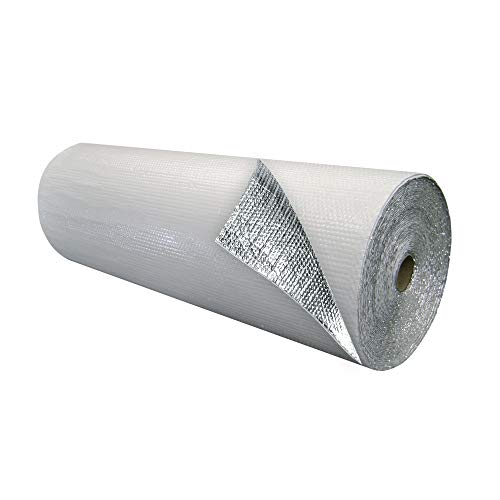
Looking to save big on your energy bills? Look no further than EcoFoil Reflective Foil Insulation. This innovative insulation material reflects an impressive 96% of radiant heat, reducing the demand on your heating and cooling systems. This translates to significant energy savings and a more comfortable indoor environment.
Not only is EcoFoil insulation effective, but it's also hassle-free to install. The lightweight material is easy to handle and transport, and it's free of itchy fibers and other irritants. You won't need any special clothing or equipment to install it, making the process quick and easy.
But don't let the ease of installation fool you – EcoFoil Reflective Foil Insulation is also built to last. The tough, flexible material can stand up to the rigors of any building project, giving you peace of mind that your investment will pay off for years to come.
EcoFoil Reflective Foil Insulation is also incredibly versatile. You can use it in a variety of settings, including pole barns, metal buildings, basement walls, crawl spaces, and storage units. It's suitable for both new construction and existing buildings, so you can retrofit your current space with ease. And because it works in any climate, it's an excellent choice for warmer regions where snow and ice aren't a concern.
So if you're looking for an effective, easy-to-install insulation solution that can help you save big on energy bills, look no further than EcoFoil Reflective Foil Insulation. With its impressive specs – including dimensions of 48" x 125', 500 sq. ft. of coverage, a thickness of 1/4", and a class 1/class A fire rating – it's a smart investment that will pay off for years to come. Plus, it's non-toxic, non-carcinogenic, fiber-free, and has no off-gassing, making it safe for you and your family.
6. Reflective Heat Shield With Fire Code Compliance.
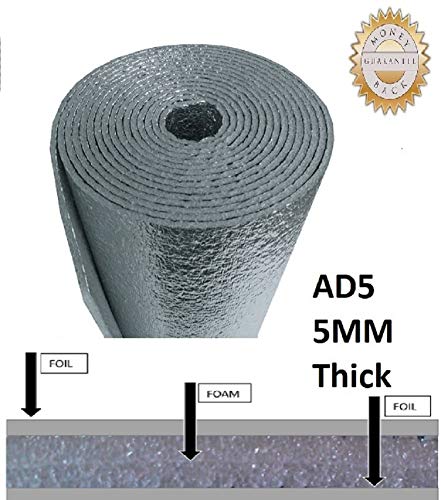
Introducing a remarkable insulation material that is both strong and lightweight – perfect for a wide range of applications. This product boasts an ASTM certification for Class 1 and Class A fire rating, ensuring maximum safety in any setting. Made with a high-quality double-sided metalized film foam core material, it provides excellent water resistance, making it ideal for use in damp environments.
Safety is always a top priority, which is why this insulation material is proudly non-toxic and will not cause any irritation to the skin, eyes, or throat. This makes it a safe and reliable choice for any project.
What sets this insulation material apart is its exceptional performance, which does not diminish over time. It remains highly effective as a vapor barrier, keeping moisture at bay and maintaining a comfortable indoor environment.
Investing in this insulation material is a smart choice for anyone looking for a high-quality and reliable solution for their insulation needs. Its strength, lightweight nature, and impressive features make it a popular choice for both residential and commercial applications.
7. Energywrap: Reflective Foam Insulation For Your Home
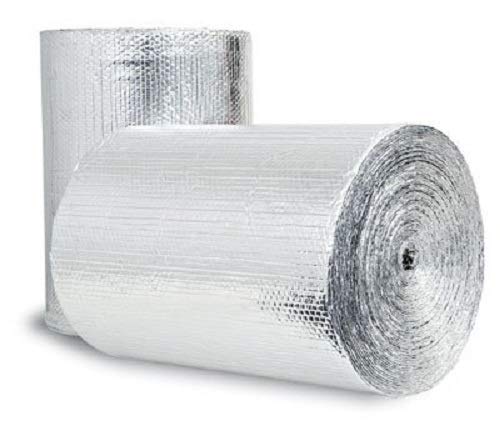
Introducing a highly reflective double-sided radiant barrier with a closed-cell foam core insulation. This industrialized strength yet lightweight insulation is designed to hold staples without tearing, and does not compress, collapse, or disintegrate. Its impressive ability to reflect 97% of radiant heat and emit less than 3% of heat makes it an excellent choice for those who prioritize energy efficiency.
This ASTM Class 1 / Class A fire-rated radiant barrier has passed the ASTM E84 test and ASTM E2599, ensuring its high quality and reliability. Additionally, it is non-toxic, non-carcinogenic, and fiber-free, making it safe to handle without the need for protective clothing or respirators during installation.
The installation process is easy and maintenance-free, and it can be cut easily with a utility knife or scissors. Installing it is easier than fiberglass, and it can be stapled, nailed, glued, or held in place with a spray adhesive. There's no mess, and no itchy fibers to worry about.
This insulation is not affected by moisture or humidity and inhibits condensation, making it a durable and long-lasting solution. It also provides the added benefits of soundproofing when used in walls, ceilings, and floors. Depending on use, it can increase your overall property value.
Each roll covers 50 square feet and is 24 inches wide and 25 feet long. The insulation is 7MM (5/16 In) thick and comes with 10Ft Foil Tape and a Razor Kit for your convenience.
Reduce stress on your heating and cooling systems, keep your home warmer in the winter and cooler in the summer, and save on utility bills all year round. Choose this highly effective and reliable radiant barrier insulation for your home or business today!
8. Ant 48" X 25' White Double Bubble Reflective Foil Insulation Thermal Barrier R8
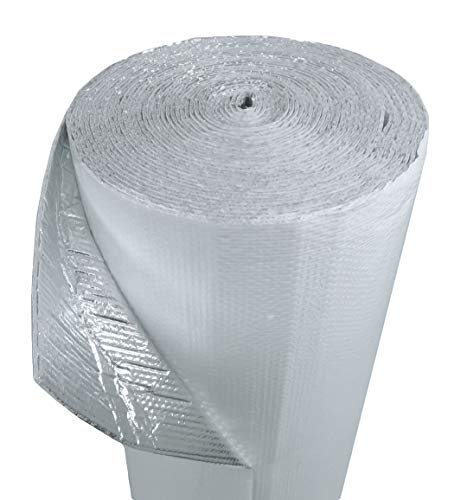
Looking for an effective solution to regulate your indoor temperature and reduce energy costs? Look no further than the Ant 48" x 25' White Double Bubble Reflective Foil Insulation Thermal Barrier R8.
This product is designed to create a thermal barrier that reflects heat radiation and blocks conductive heat transfer. With an R-value of 8, it provides excellent insulation, ensuring that your indoor space stays cooler in the summer and warmer in the winter. It's made with high-quality materials that are durable and long-lasting, so you can enjoy the benefits of this insulation for years to come.
The Ant 48" x 25' White Double Bubble Reflective Foil Insulation Thermal Barrier is easy to install, making it a great option for both homeowners and contractors. Simply cut the insulation to fit the desired area and staple or tape it in place. It's lightweight and flexible, so it can be easily manipulated to fit any space.
This insulation is also environmentally friendly, as it is made with 100% recyclable materials. It's also non-toxic and safe for use in any indoor environment.
9. Green Energy Radiant Barrier With Nasa Tech
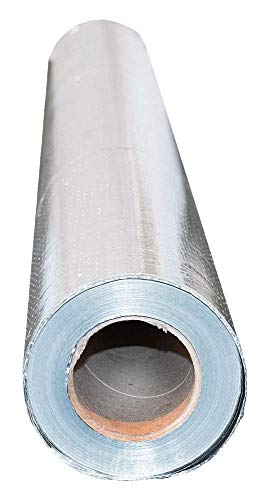
This radiant barrier foil roll is an excellent solution for reducing cooling costs and keeping your home cool during hot summers. It comes in a roll that covers 500 square feet, with a width of 25.5 inches. The foil is highly reflective, double-sided, and tear-resistant, designed to reflect radiant heat instead of absorbing it. It is remarkably thin to the touch and can withstand heavy handling without tearing, puncturing, or overly wrinkling. You can cut it easily with utility scissors and install it properly with ease, without requiring any special tools or protective equipment.
The foil is non-toxic, does not promote the growth of fungi or bacteria, and does not provide any nesting support for rodents or insects. It works for both new and pre-existing buildings and is unaffected by humidity and climate changes. Once installed, no further maintenance is required. Unlike bulky insulation such as foil-faced bubble wrap, this radiant foil is an excellent alternative.
This radiant foil is also ASTM compliant, meeting the American Society for Testing and Materials (ASTM) fire and smoke safety requirements of most state and local building codes, as well as the breathability standards for building materials. It is primarily used for attic rafters and floors, but it also works well for garages, workshops, storage units, barns, warehouses, and even older multi-storied homes that lack sufficient insulation.
Additionally, the radiant barrier foil roll comes with a 90-day 100% money-back guarantee. The company offers a no-hassle return policy, and if you are not completely satisfied with your purchase for any reason within the first three months, simply let them know, and they will refund you all your money.
10. Nasa Tech Green Energy Radiant Barrier Foil.

Looking for a radiant barrier that can effectively reflect radiant heat and withstand heavy handling? Look no further than this Heavy Duty Commercial Industrial Grade perforated breathable radiant barrier!
Each roll of this barrier measures 25.5 inches by 470.4 feet, providing a total of 1,000 square feet of coverage. This is the strongest radiant barrier on the market, with a double-sided (5ply) construction that is tear-proof and highly reflective. In fact, it boasts a 99.97% Reflective E Value, ensuring that it reflects radiant heat rather than absorbing it.
Designed to withstand heavy handling and traffic without tearing, puncturing, or overly wrinkling, this Commercial Grade Industrialized Barrier is easy to cut with a utility knife or scissors for hassle-free installation. It is ASTM compliant and meets the American Society for Testing and Materials (ASTM) Class 1 Class A fire and smoke safety requirements of most state and local building codes, as well as the breathability standards for building materials.
While primarily used for attic rafters and floors, this radiant foil works equally well for garages, workshops, storage units, barns, warehouses, and even older multi-storied homes that lack sufficient insulation. And with the 120-day 100% money-back guarantee, you can be confident in your purchase. If you are not completely satisfied with your purchase for any reason within four months, just let the seller know and they will refund all your money.
Best Insulation For Mobile Home Roof FAQs
Can I install insulation myself, or do I need to hire a professional for my mobile home roof?
Yes, you can install insulation yourself if you have the necessary skills and tools. However, it is advisable to hire a professional for your mobile home roof insulation to ensure that it is done correctly. A professional will have the expertise and experience needed to assess your home's specific needs and recommend the best type of insulation for your roof.
Installing insulation can be a complex process, especially in a mobile home, and if done incorrectly, it can lead to issues such as moisture buildup, mold growth, and reduced energy efficiency. A professional insulation contractor will know how to properly install insulation and ensure that your home is well-insulated and energy-efficient.
Moreover, a professional may be able to provide you with warranties and guarantees for their work, giving you peace of mind knowing that your investment is protected. So, while it is possible to install insulation yourself, hiring a professional for your mobile home roof insulation is a smart choice.
How can I tell if my mobile home roof insulation needs to be replaced?
There are several signs that can indicate if your mobile home roof insulation needs to be replaced. The first sign is water damage or discoloration on the ceiling or walls, which can occur due to leaks caused by damaged or worn-out insulation. Another sign is a sudden increase in your energy bills, which can be a result of poor insulation that is causing your HVAC system to work harder to maintain a comfortable temperature. You may also notice drafts or cold spots in your home, which can be a sign that your insulation has become compressed or damaged, reducing its effectiveness. If you suspect that your mobile home roof insulation needs to be replaced, it is best to hire a professional roofing contractor to inspect your roof and provide you with an accurate assessment. They can determine the type of insulation you have, its current condition, and recommend the best course of action to improve its effectiveness and ensure your home stays comfortable and energy-efficient.
How do I determine the R-value needed for my mobile home roof insulation?
The R-value is a measure of the thermal resistance of insulation, indicating how well it can resist heat flow. The higher the R-value, the more effective the insulation. To determine the R-value needed for your mobile home roof insulation, you need to consider several factors.
First, you should consider the climate in your area. The colder the climate, the higher the R-value you will need to keep your home warm. You can find the recommended R-values for different regions from the Department of Energy or local building codes.
Second, you should consider the type of insulation you want to use. There are different types of insulation materials available, such as fiberglass, cellulose, and spray foam insulation. Each type has different R-values per inch, so you need to choose the one that meets your R-value requirement.
Third, you should consider the thickness of insulation you need. The thicker the insulation, the higher the R-value. However, you should not exceed the thickness that your roof can accommodate.
In summary, to determine the R-value needed for your mobile home roof insulation, you should consider the climate in your area, the type of insulation, and the thickness of insulation you need.
How do I prevent moisture buildup in my mobile home roof insulation?
Preventing moisture buildup in your mobile home roof insulation is essential to avoid damage and health hazards. Here are some steps you can take to prevent moisture buildup:
1. Proper Ventilation: Ensure that your mobile home has adequate ventilation to allow the air to circulate, which will prevent moisture buildup. Make sure there are enough vents in the attic and that they are not blocked.
2. Seal Leaks: Any leaks in the roof should be sealed to prevent moisture from seeping into the insulation.
3. Proper Insulation: Make sure that the insulation used in your mobile home is suitable for your climate and is installed correctly. This will prevent moisture buildup and keep your home comfortable.
4. Monitor Humidity Levels: Keep an eye on the humidity levels in your mobile home. If they are too high, use a dehumidifier to reduce the moisture in the air.
5. Regular Maintenance: Regularly inspect your roof and insulation for any signs of damage or moisture buildup. If you notice any issues, address them immediately to avoid further damage.
By following these steps, you can prevent moisture buildup in your mobile home roof insulation, which will keep your home safe and comfortable.
How much does it cost to insulate a mobile home roof with the best materials?
The cost of insulating a mobile home roof with the best materials will depend on various factors like the size of the roof, the type of insulation material, and the complexity of the installation process. However, on average, the cost can range from $1,000 to $5,000. The best insulation materials for mobile home roofs are spray foam insulation, rigid foam board insulation, and blown-in cellulose insulation. Spray foam insulation is one of the most expensive options but provides excellent insulation and has a long lifespan. Rigid foam board insulation is also a great option as it is easy to install and has a high R-value. Blown-in cellulose insulation is the most cost-effective option and is environmentally friendly. It is essential to hire a professional contractor for the installation process to ensure that the insulation is properly installed and provides the desired results.
Is fiberglass insulation a good choice for mobile home roofs?
Fiberglass insulation can be a good choice for mobile home roofs, depending on various factors. Fiberglass insulation is lightweight, easy to install, and provides excellent thermal insulation properties. It can help reduce energy costs by preventing heat loss in the winter and heat gain in the summer.
However, it is important to note that fiberglass insulation is not a good choice for areas with high moisture content. If the roof of the mobile home is prone to leaks or condensation, fiberglass insulation may not be the best option as it can absorb moisture and become less effective. In such cases, closed-cell spray foam insulation or rigid foam insulation may be a better choice.
Another factor to consider is the R-value, or thermal resistance, of the insulation. The R-value indicates the insulation's ability to resist heat flow, and a higher R-value means better insulation performance. It is important to choose the appropriate R-value for the specific climate zone and the mobile home's construction.
In summary, fiberglass insulation can be a good choice for mobile home roofs if moisture is not a concern and the appropriate R-value is selected. It is advisable to consult with a professional insulation contractor to determine the best insulation option for the specific situation.
What are the benefits of using spray foam insulation for mobile home roofs?
Spray foam insulation is a popular option for mobile home roofs due to its numerous benefits. Firstly, spray foam insulation provides superior energy efficiency, as it forms an airtight seal that prevents air leakage and heat transfer. This means that the interior of the mobile home stays comfortable and consistent in temperature, reducing the need for heating and cooling systems.
In addition, spray foam insulation can help to prevent moisture and condensation buildup in the roof, which can lead to mold growth and structural damage. This can help to extend the lifespan of the roof and reduce maintenance costs.
Another benefit of spray foam insulation is that it can help to improve the structural integrity of the mobile home roof, as it adheres to the surface and provides additional support. This can help to prevent damage from strong winds or heavy snow loads.
Overall, using spray foam insulation for mobile home roofs is a cost-effective and efficient way to improve energy efficiency, prevent moisture buildup, and enhance the structural integrity of the roof.
What is the lifespan of the best insulation for mobile home roofs?
The lifespan of insulation for mobile home roofs can vary depending on a number of factors such as the type of insulation used, the quality of installation, and the climate in which the home is located. Generally, the best insulation for mobile home roofs is spray foam insulation, which has a lifespan of around 20-30 years. However, this lifespan can be extended with proper maintenance and upkeep.
It is important to note that other types of insulation, such as fiberglass or cellulose, may have a shorter lifespan and may not be as effective in providing insulation for mobile home roofs. Additionally, factors such as moisture and pests can also impact the lifespan of insulation, so it is important to address any issues promptly to ensure optimal performance.
Ultimately, investing in high-quality insulation and ensuring proper installation and maintenance can help extend the lifespan of insulation for mobile home roofs and improve energy efficiency and comfort in the long run.
What is the most effective insulation material for a mobile home roof?
The most effective insulation material for a mobile home roof depends on various factors such as the climate, budget, and personal preferences. However, some commonly used insulation materials for mobile home roofs include fiberglass, spray foam, and rigid foam boards.
Fiberglass insulation is one of the most popular choices due to its affordability and ease of installation. It is made of tiny glass fibers that trap heat, preventing it from escaping the home.
Spray foam insulation is another option that is known for its excellent air-sealing properties. It is applied as a liquid that expands and hardens, filling all crevices and gaps in the roof.
Rigid foam boards are a more expensive but highly effective option. They offer high R-values (thermal resistance), making them ideal for extreme climates.
Ultimately, the best insulation material for a mobile home roof will depend on individual needs and preferences. It is recommended to consult with a professional to determine the most suitable insulation for your specific situation.
Will the best insulation for mobile home roofs help with energy efficiency and lower my utility bills?
Yes, installing the best insulation for mobile home roofs can significantly improve energy efficiency and lower your utility bills. A well-insulated roof can prevent heat loss during winter and keep the interior cooler during summer, reducing the need for heating and cooling systems. This means you can save money on your energy bills while also reducing your carbon footprint.
There are several types of insulation materials available for mobile home roofs, including fiberglass, spray foam, cellulose, and reflective foil. The best option depends on your budget, climate, and personal preferences. Fiberglass insulation is affordable and easy to install, while spray foam provides better insulation and air sealing. Cellulose insulation is eco-friendly and provides excellent soundproofing, while reflective foil can reflect sunlight and reduce heat gain.
To ensure maximum energy efficiency, it's important to choose the right insulation material and have it installed by a professional. A properly insulated mobile home roof can provide long-term energy savings and increase your overall comfort.







